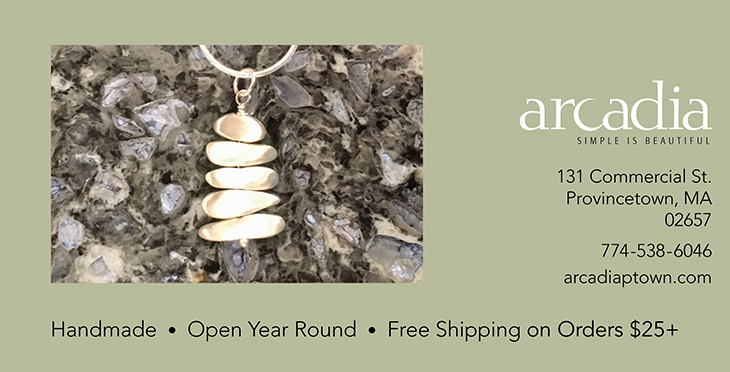Last fall, Rob DuToit was walking in the Audubon sanctuary in Wellfleet when he approached a platform with a sweeping view of the marsh and Cape Cod Bay. The scene reminded him of the work of Claude Lorrain, a 17th-century French painter of grand landscapes and mythological scenes. DuToit returned to the spot shortly afterward with a 30-by-40-inch blank canvas.
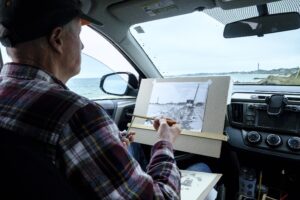
The resulting oil painting, Looking Towards Great Island Wellfleet, embodies what he loves about Claude Lorrain: the articulation of “continuous space” in which the viewer has the feeling of moving through space in the painting.
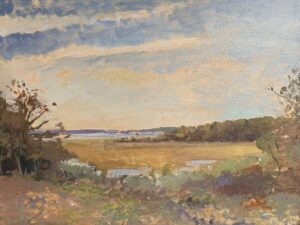
“Lorrain’s trademark was the repoussoir,” says DuToit, referring to the artist’s compositional strategy of prominently placing large trees on the left or right side of a picture. “The space moves from the foreground, around the trees, and then way out into the distance into some kind of incredible luminous light.”
DuToit follows this strategy in his Wellfleet painting. It invites the viewer into the foreground — a tangle of low-lying shrubs colored with autumnal greens, purples, and oranges — before encountering two spindly trees on the left and right, that, like Lorrain’s trees, build anticipation and slow the progression before the grand release: a swath of golden marsh, a blue strip of glistening water in the distance, and a gleaming sky. “It’s an emotional space, not an illustrated space,” says DuToit.
DuToit, who grew up in Winchester, has been fascinated by deep, open space since childhood. He recalls visiting his grandmother, sitting on her porch and looking out at a big field as adults talked in the background. “I remember sitting there with my hands on the railing and my head on my hands and just being mesmerized by the vastness of it,” he says. “Something about space and light and distance is almost spiritual for me.”
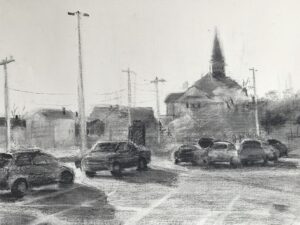
For DuToit, 69, art history’s old masters have long been an inspiration — Lorrain and Camille Corot chief among them. But they’ve also been a burden. In earlier years, DuToit struggled, making work that at times felt too referential, too studied, or overworked.
In his 40s, he stopped painting for a few years. “I felt like I was destroying everything,” says DuToit. “I had to pull back.” During that time, he began making ink drawings, something he had done as a child when he was given a pen-and-ink kit at age nine. The limitations of the material forced DuToit to work spontaneously and not second-guess his decisions. He continues to work with ink, which, along with pastels, allows him a sense of freedom that hasn’t always been easy to achieve in oil paint.
In Days Cottages, one of the ink drawings on view in his exhibition opening this week at Berta Walker Gallery, where he’s been represented for almost 20 years, the image quivers with the immediacy of DuToit’s touch. He matter-of-factly executes lines of varying thickness to render telephone poles and their wires lining the road. The mineral paper he uses for his drawings is slick, so ink sits on the surface, running, dripping, and overlapping in a way that doesn’t hide its flaws. In Days Cottages, ink is a physical material, not just a tool of description. But the image, with its expansive range of values and raking light, also reveals the skill of a painter who has worked from observation for years.
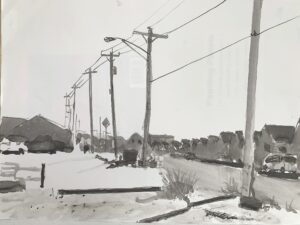
DuToit’s recent paintings show an artist benefiting from years of study but with the seasoned confidence to hold that influence lightly. His ink drawings led the way to this result. The drawings — which he considers “direct, alive things” with “nothing between me and the paper” — became a model and strategy for his oil paintings.
In Looking Towards Great Island Wellfleet and East End Evening, another plein air landscape painting of the same size, DuToit paints with loose, energetic abandon. The telephone poles in East End Evening, as in his ink drawings, are fast, casual gestures. The rocks in the foreground are rendered with plucky, calligraphic marks, and the road and shore are laid down quickly in thin washes of dirty purple paint. For the sky, he used rags, brushes, and his fingers to create exuberant light, ranging from a glow above the horizon to darker clouds overhead.
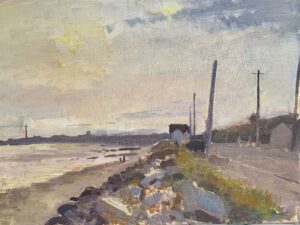
East End Evening was painted from the edge of Provincetown Harbor and Commercial Street’s easternmost stretch. It was a vantage point from which the late Arthur Cohen, a friend of DuToit’s, often worked. DuToit started painting there about a year after Cohen’s death in 2012.
“There’s something magical about that spot,” says DuToit. Once, when he was working there, writer Roger Skillings walked by and commented on how the view of Provincetown in the distance and bowl-like shape of the harbor looked like two arms almost touching.
DuToit brings his own sensibility — a flickering touch, soft color, a sensitivity to the way light moves across surfaces — to a local motif painted by Cohen and many others. “I see what they found in that spot, and I want to see what I can find,” he says. He paints with others in view, whether old masters like Lorraine or Corot, or his peers, like Diana Horowitz or Donald Beal. “It’s like family,” says DuToit. “It’s connection.”
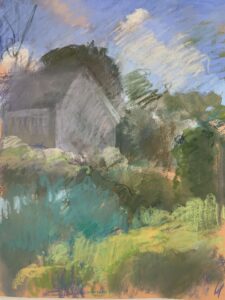
An especially inspiring figure for DuToit is Paul Resika, whom DuToit studied under in an M.F.A. program at the Parsons School of Design in New York. Resika’s modern paintings that referenced Corot and others from art history “were so exciting,” says DuToit. “They were alive.”
After graduating from Parsons in 1981, DuToit stuck around New York for a few years and learned the craft of picture framing, which he continues to do. In 1985, he came to Provincetown to attend Beal’s wedding. They had been classmates at Parsons. DuToit didn’t want to go home, and Resika, who has been connected to the Outer Cape for many decades, helped him find a place to live in Wellfleet. Eventually, he found a studio in Provincetown where painter Fritz Bultman once worked. DuToit now lives in Truro with his wife, sculptor Janice Redman, and continues to paint in the same studio, which conjures an atmosphere of an earlier time in Provincetown with its simple, modern design, natural light, smell of oil paint, and woodsy environs.
With the advantage of age, DuToit says he’s more carefree in his artistic practice. “I’m not so worried about making perfect paintings,” he says. This freedom is what makes his recent work soar.
Paintings and Drawings
The event: An exhibition of recent work by Rob DuToit
The time: May 23 to June 15; opening reception, Friday, May 23, 5 to 7 p.m.
The place: Berta Walker Gallery, 208 Bradford St, Provincetown
The cost: Free
